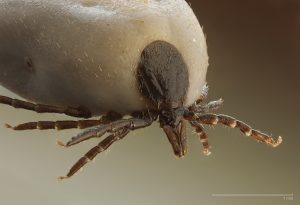Shorts and short sleeves signal the coming of spring and summer, but they are often accompanied by the leaping and biting of ticks.
While ticks are present in Bucks County every year, the threat is a worse this spring than it has been in past years.
Dr. Richard Cooper is an entomologist (someone who studies insects) and one of the owners of Cooper Pest Solutions. He has about 30 years of experience in the pest control industry, and by far, spring of 2017 is the worst for ticks in his memory.
The mild Winter Bucks County experienced, in addition to the bustling rodent population means that ticks are more prevalent than as far as Cooper can remember.
“This is probably the worst tick season that we have ever seen as far as my history in the industry,” Cooper explained.
The higher survival rate in ticks likely means that more people are getting bitten. More bites means potentially more disease being spread, which is the scariest part of getting bitten by a tick.
Of the seven human-biting ticks that are commonly known to live in the United States, the Centers for Disease Control and Prevention reports four are known to inhabit the Bucks County region.
From the CDC:
Ticks find their hosts by detecting animals´ breath and body odors, or by sensing body heat, moisture, and vibrations. Some species can even recognize a shadow. In addition, ticks pick a place to wait by identifying well-used paths. Then they wait for a host, resting on the tips of grasses and shrubs. Ticks can’t fly or jump, but many tick species wait in a position known as “questing”.
While questing, ticks hold onto leaves and grass by their third and fourth pair of legs. They hold the first pair of legs outstretched, waiting to climb on to the host. When a host brushes the spot where a tick is waiting, it quickly climbs aboard. Some ticks will attach quickly and others will wander, looking for places like the ear, or other areas where the skin is thinner.
The most notable disease that people associate with ticks is Lyme disease. If it isn’t treated early, it can lead to a lifetime of symptoms. Early lyme indicators include a spreading rash, fever, muscle aches and headaches, according to Dr. Ronald Goren, a specialist in infectious diseases at St. Mary’s Medical Center in Middletown.
As far as people coming into the doctor or emergency room for tick bites, there is not an easily searchable database. Dr. David Jaslow, the medical director of the emergency department at Lower Bucks Hospital in Bristol Township explained that while there are people coming into the emergency room, it is impossible to tell just how many.
“You never really know whether incidents are going up or if reporting is going up,” Jaslow explained.
The best way to protect yourself from tick borne illnesses is prevention, according to Jaslow.
“If a tick bites you, you really have no control over what diseases the tick is carrying,” Jaslow said. “The key is to do an inspection as close as possible to when you leave a wooded area,” he added.
“They want you to wear long sleeves and long pants, but that is not something people are going to do (in warm weather),” Goren said with a laugh.
Otherwise, DEET-based repellents such as Off! can help to keep ticks from biting, experts said.
If you are bitten by a tick, as long as it is removed within about 24 hours, there is a very low chance that that any diseases it was carrying would be transmitted, according to Cooper.
The Powassan virus has made headlines recently. According to Goren and Cooper, while the disease is dangerous, it is so rare that most regular folks shouldn’t be too worried about contracting it. Prevention is key for the Powassan virus. According to Cooper, there is no confirmed time for transmission, but it is substantially shorter than the 24 hours other tick-borne diseases demand.
In the case you come across a tick while checking yourself or someone else, you can remove it with a pair of fine tweezers by gripping it as close to the mouth as possible and pulling straight up, Cooper explained.
“Avoid folklore remedies such as “painting” the tick with nail polish or petroleum jelly, or using heat to make the tick detach from the skin. Your goal is to remove the tick as quickly as possible–not waiting for it to detach,” the CDC states in their medical literature.










